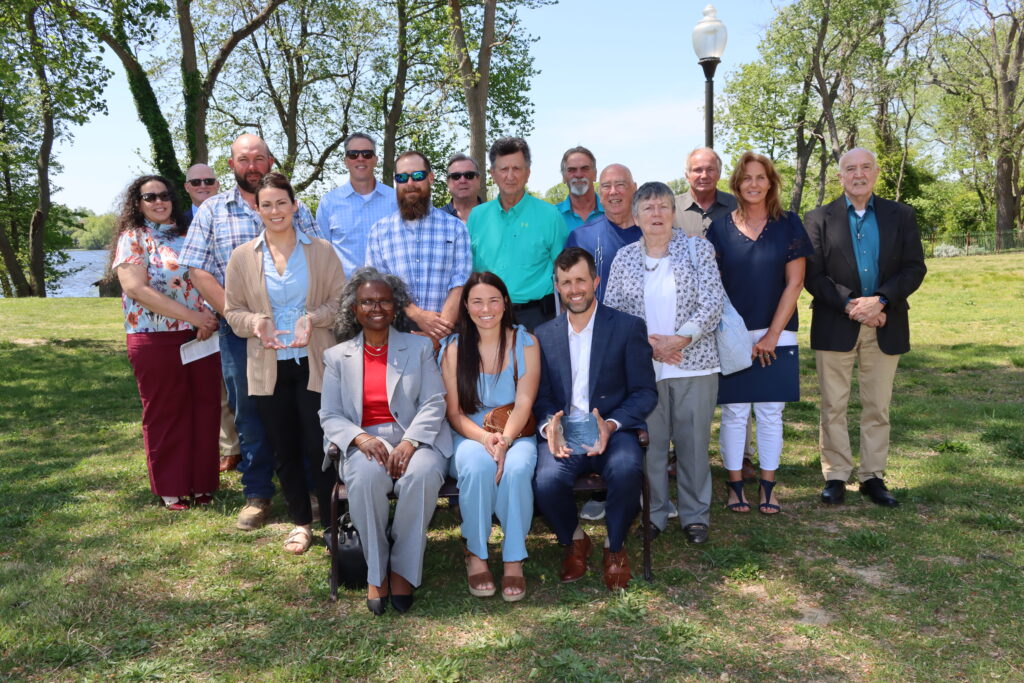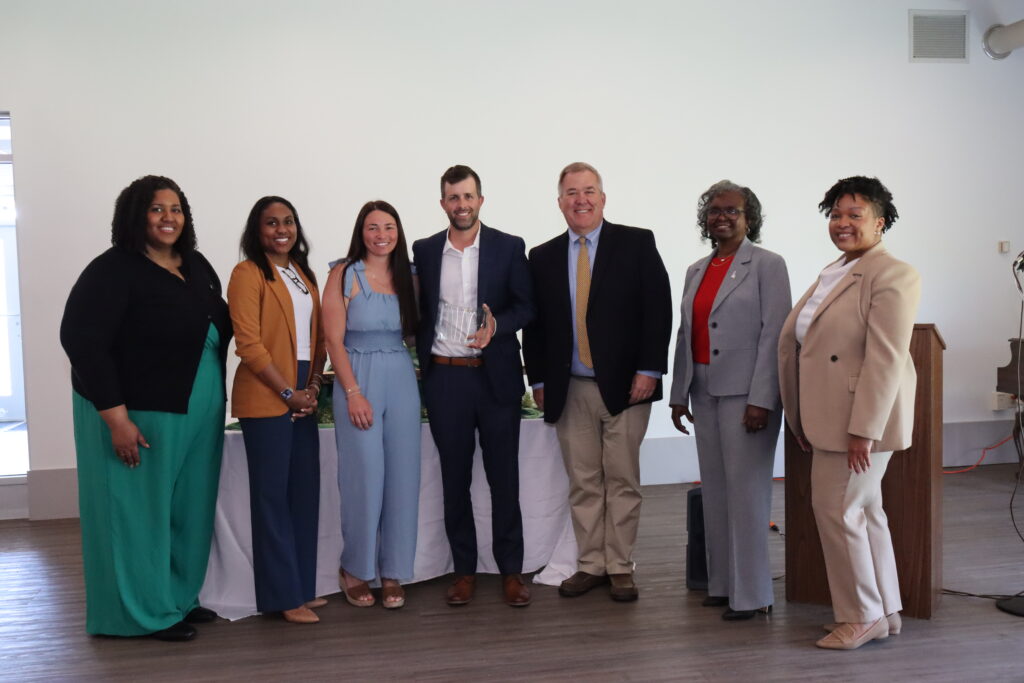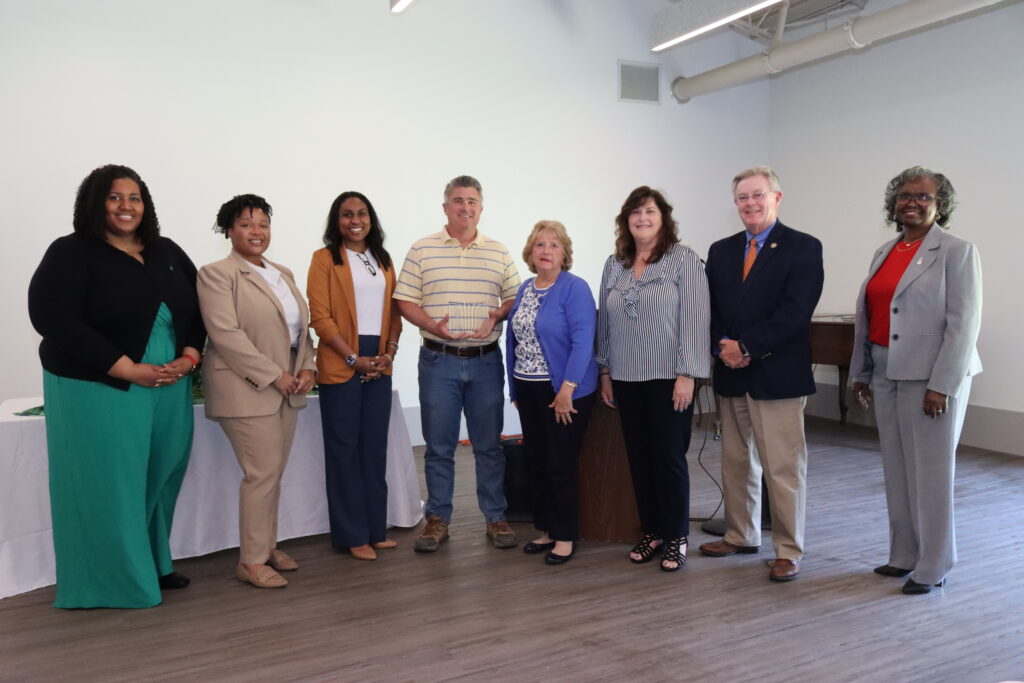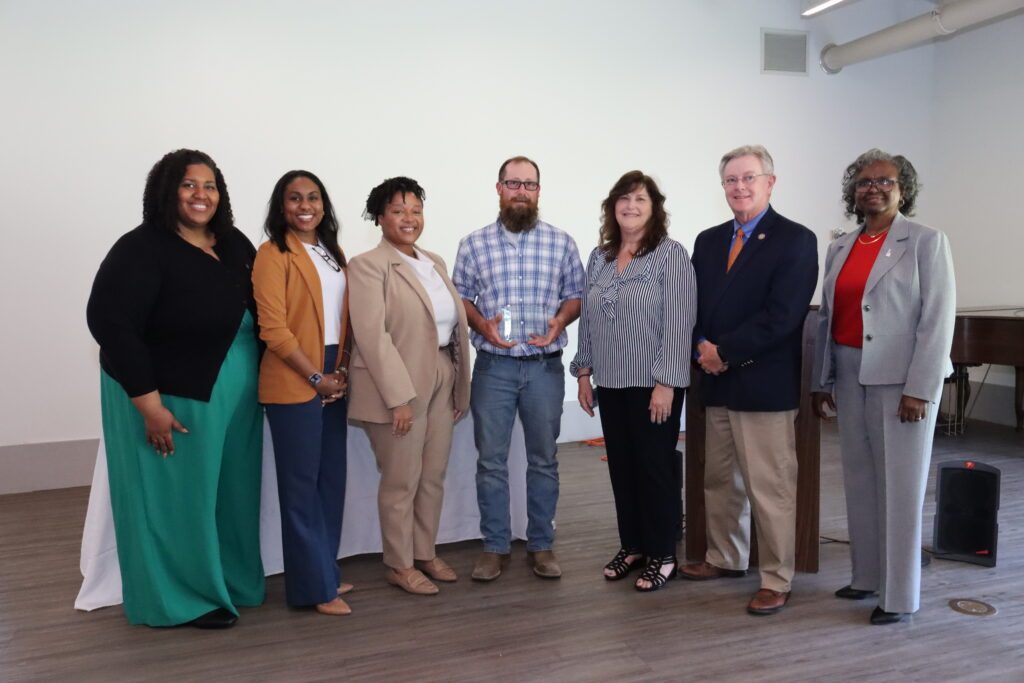
DOVER (April 29, 2025) – A ceremony marked the annual Governor’s Agricultural and Urban Conservation Awards today. Delaware Association of Conservation Districts President Gwen Pierce, DNREC Deputy Secretary Dayna Cobb and USDA-Natural Resources Conservation Service Acting State Conservationist Shantel King were joined by Governor Meyers’ Deputy Chief of Staff Nikko Brady to lead a ceremony recognizing this year’s honorees and signed a proclamation officially designating April 27 – May 4 as Stewardship Week in Delaware under the theme, “Home is Where the Habitat is.”
 “This year’s theme “Home is Where the Habitat Is”, highlights the essential role that both natural and managed habitats play in supporting biodiversity and maintaining ecological balance. But this theme is more than just a catchy phrase – it’s a reminder that every habitat, from sprawling forests to bustling urban parks, contributes to the health of our planet.” said Pierce.
“This year’s theme “Home is Where the Habitat Is”, highlights the essential role that both natural and managed habitats play in supporting biodiversity and maintaining ecological balance. But this theme is more than just a catchy phrase – it’s a reminder that every habitat, from sprawling forests to bustling urban parks, contributes to the health of our planet.” said Pierce.
“Stewardship Week helps to remind us all of the power each person has to conserve natural resources and improve our world.” said Pierce, “The Stewardship concept involves personal and social responsibility, including a duty to learn about and improve natural resources as we use them wisely, leaving a rich legacy for future generations.”
This year’s agricultural honorees include Fifer Orchards, a Kent County farm dedicated to specialty crops and growing agritourism; Jerry Dukes, a Sussex County a third-generation farmer whose commitment to conservation and sustainability has impacted Delaware agriculture; And Michael G Kitts and Family, a beef, cattle and cropland farmer dedicated to using best management practices and working with partners.
Urban conservation award recipients demonstrate innovation and exceptional community service. Mr. Strauss of Kent County addressed many environmental issues by making sinkhole repairs in established subdivisions and repairs of malfunctioning structures within BMPs. His use of updated Erosion and Sediment Control techniques supported the Stormwater Maintenance District. In Sussex County, The Chapel Green Homeowners Association turned an unused community drain field into a thriving, multi-habitat ecosystem; New Castle County recognized the Independence School for their Stream Stabilization Project. The practices used in this project have broad applicability for stream-bank stabilization engineering and design.
“Today’s recipients work with Delaware’s conservation partners to implement innovative and comprehensive conservation practices on their farms and in their businesses and projects.” said Pierce. “Delaware is fortunate to have a wonderful partnership between Delaware’s conservation districts, DNREC and NRCS, who provide invaluable support to our cooperators. These awards highlight the beneficial outcomes of these relationships, and we’d like to take a moment to recognize the hard work that’s been done.”
 Representative Jesse Vanderwende was recognized as DACD’s Legislator of the Year. A dedicated advocate for Delaware’s agricultural community, Representative Jesse Vanderwende has played a pivotal role in supporting farmers, conservation initiatives, and rural development. A Sussex County native and lifelong farmer, Vanderwende brings firsthand experience to his work in the General Assembly, ensuring that Delaware’s top industry—agriculture—remains strong and sustainable.
Representative Jesse Vanderwende was recognized as DACD’s Legislator of the Year. A dedicated advocate for Delaware’s agricultural community, Representative Jesse Vanderwende has played a pivotal role in supporting farmers, conservation initiatives, and rural development. A Sussex County native and lifelong farmer, Vanderwende brings firsthand experience to his work in the General Assembly, ensuring that Delaware’s top industry—agriculture—remains strong and sustainable.
Since taking office, Representative Vanderwende has championed policies that enhance agricultural viability, promote conservation, and improve drainage and flood control—critical issues for Sussex County farmers. He has been a tremendous advocate for funding cover crop programs and voluntary conservation practices that protect water quality and soil health. He is also a strong supporter of Delaware’s tax ditch system, recognizing its vital role in both residential and agricultural areas across his district.
Delaware’s Conservation Districts, one in each county, are a unique governmental unit in partnership with DNREC. Their mission is to provide technical and financial assistance to help Delawareans conserve and improve their local natural resources, including solving land, water and related resource problems; developing conservation programs to solve them; enlisting and coordinating help from public and private sources to accomplish these goals; and increasing awareness of the inter-relationship between human activities and the natural environment. Delaware’s district supervisors have a statewide organization, the Delaware Association of Conservation Districts (DACD), a voluntary, non-profit alliance that provides a forum for discussion and coordination among the Conservation Districts.
Additional details for this year’s Conservation Award winners:
New Castle

AGRICULTURAL: Michael G. Kitts Jr. and Family
Michael Kitts signed up for the USDA-FSA Beginning Farmer Loan Program in 2018 to purchase his home farm at Alley Mill with his wife Rachel and two children, Gracie and Little Mike. Since then, Mike has incorporated best management practices and participated in New Castle Conservation District and NRCS programs for his beef cattle operation and expanded his operation to over 1800 acres of owned and rented cropland.
Mike has been aggressively planting cover crops to improve soil health and reduce losses of surplus nitrogen and phosphorus due to groundwater leaching or excess soil erosion. Mike has also implemented nutrient management plans on the cropland he tills as required by the Delaware Nutrient Management Program. Cover crop planting in combination with nutrient management and yield mapping provides Mike with the best available information to fine tune the application of increasingly expensive fertilizers and soil amendments.

URBAN: The Independence School Stream Stabilization Project
The Independence School Stream Stabilization Project consisted of 360 feet of restoration of an unnamed tributary of Pike Creek, which is part of the Wild and Scenic White Clay Creek watershed. The tributary stream was eroding towards one of the School’s main access roads and the bank erosion had exposed an electric cable-line posing a safety hazard. High stream flows during storm events resulted in frequent out-of-bank flooding and was also cutting into the stream bed.
The project included an imbricated rock seat wall and a boulder path through the tributary stream so that it can also be used as an outdoor classroom. Also, the project used large rocks, log sills, log vanes, and recycled tree-root wads to reconfigure a more resilient, reshaped stream banks. The centerline of the stream was stabilized with cobble and scattered boulders. The stream channel was relocated away from the shoreline. The stream channel was also relocated on the opposite side of an existing Sycamore tree in order to save the tree.
Kent

AGRICULTURAL: Fifer Orchards
Fifer Orchards began in 1919 as a diverse specialty crop farm. Today, this Century Farm grows a variety of fruits and vegetables as well as conventional field crops. They distribute their produce to many regional and local locations, including local Delmarva restaurants and Delaware schools. They are also helping to build agritourism in Kent County. Their mission statement, “To grow and sell high quality produce, while preserving the environment, serving the community and maintaining family values” is one that they’ve upheld for over 100 years.
Fifer Orchards tests and utilizes a variety of new and innovative practices in all aspects of their production that can be utilized in a multitude of different production scenarios. They currently use practices such as crop rotation, nutrient management, integrated pest management (IPM), and diverse cover crops to improve soil health, reduce compaction and erosion and improve water quality.

URBAN: Jason Strauss
Mr. Strauss addressed many environmental issues by making sinkhole repairs in established subdivisions and repairs of malfunctioning structures within BMPs. Removal of sediment and debris that would otherwise makes its way into nearby waterways. His use of updated Erosion and Sediment Control techniques supported the Stormwater Maintenance District.
Timely and efficient repairs and maintenance on stormwater facilities, BMPS, and conveyances provide all communities that ability to have proper stormwater and nutrient control to continue to protect the states critical water infrastructure while supporting a joint community/public agency partnership.
Sussex

AGRICULTURAL: Jerry Dukes
A dedicated steward of the land and a proud Sussex County native, Jerry Dukes is a third-generation farmer whose commitment to conservation and sustainability has impacted Delaware agriculture. Managing 1,800 acres of crops and a broiler operation, Jerry has spent decades integrating conservation-minded practices into his operation to ensure the health of his land for future generations.
Jerry understands the importance of balancing production with environmental stewardship. His willingness to embrace new ideas and innovative conservation strategies has not only improved the productivity of his operation but has also enhanced the overall health of the soil and water resources in Sussex County.

URBAN: The Chapel Green Homeowners Association
The Chapel Green Homeowners Association turned an unused community drain field into a thriving, multi-habitat ecosystem. Rather than allowing the space to be developed, HOA President Jean Rothenberger led efforts to partner with DNREC’s Water Quality Improvement Program and the Center for the Inland Bays, transforming 10 acres into 20 pocket forests set within a native meadow.
With funding from state and community grants, nearly 100 donated loblolly pine seedlings, and 150 volunteer hours, residents planted, mulched, and protected the young trees. This forest-meadow complex reduces stormwater runoff, filters nutrients, improves air and soil quality, and provides pollinator habitat and wildlife corridors—all while enhancing community green space.